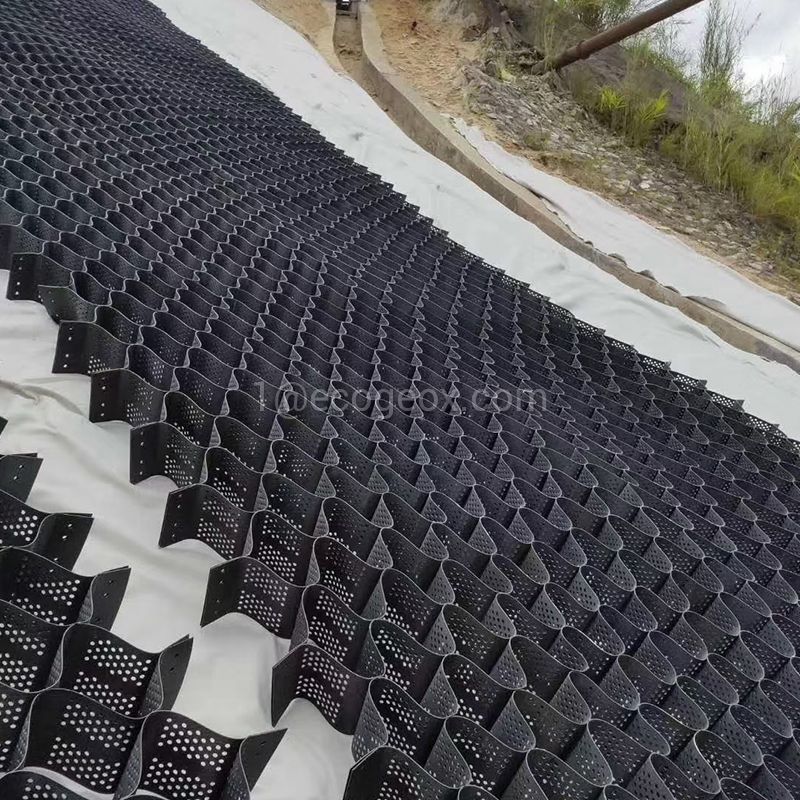Geocell is a versatile and innovative material used in various civil engineering applications. Its unique cellular structure provides reinforcement, stabilization, and erosion control in a wide range of construction projects. Let's explore some of the key applications and uses of geocell in civil engineering:

Soil Stabilization:
One of the primary applications of geocell is soil stabilization. Geocell is used to reinforce weak soils and improve their load-bearing capacity. It effectively distributes loads and reduces soil settlement, preventing soil erosion and enhancing the stability of the ground. Geocell is commonly used in road and railway construction, embankments, and parking areas to improve the overall performance of the soil foundation.
Erosion Control:
Geocell is highly effective in erosion control applications. When installed on slopes and embankments, geocell prevents soil erosion caused by water flow. The interconnected cells of the geocell system confine soil particles, reducing surface erosion and preventing the loss of topsoil. It helps to stabilize slopes, protect against surface runoff, and maintain the integrity of the landscape.
Retaining Walls and Abutments:
Geocell is widely used in the construction of retaining walls and abutments. It provides structural stability by confining soil and preventing lateral movement. Geocell walls can be filled with a variety of materials such as soil, aggregate, or concrete, creating a reinforced structure capable of withstanding high vertical and horizontal loads. The use of geocell in retaining walls reduces the amount of traditional backfill material required, resulting in cost savings and reduced environmental impact.
Load Support and Pavement Reinforcement:
Geocell is employed as a load support system in pavement construction. It helps distribute loads uniformly, reducing stress and extending the life of the pavement. Geocell confinement improves the load-bearing capacity of the base layer, minimizing deformation and rutting. Additionally, geocell can be used in the reinforcement of unpaved roads and parking lots, providing a stable and durable surface for vehicular traffic.
Green Spaces and Landscaping:
Geocell is utilized in the creation and stabilization of green spaces and landscaping features. It can be filled with soil or other growth media to create a stable foundation for vegetation. Geocell confines the growth media, preventing erosion and maintaining the integrity of the landscaping elements. It is commonly used in the construction of green roofs, vegetated slopes, and landscape terraces.
Channel and Drainage Systems:
Geocell is employed in the construction of channel and drainage systems to control and direct water flow. The cellular structure of geocell provides stability and prevents erosion along watercourses, canals, and riverbanks. It can be filled with gravel or aggregate to create stable and durable drainage channels, protecting against scour and facilitating proper water management.
Retention and Reinforcement of Fills:
Geocell is used to retain and reinforce fill materials in various construction projects. It provides lateral confinement, preventing the spreading and movement of fill materials. Geocell confinement enhances the stability of slopes, berms, and embankments, allowing for the construction of taller and steeper structures. It is widely used in the reinforcement of mechanically stabilized earth (MSE) structures.
Environmental Protection and Land Reclamation:
Geocell plays a crucial role in environmental protection and land reclamation projects. It is used to stabilize and restore areas affected by erosion, soil degradation, or mining activities. Geocell helps control erosion, promote vegetation growth, and restore the natural landscape. It is employed in projects such as mine reclamation, coastal protection, and wetland restoration.
In conclusion, geocell is a versatile and effective material with numerous applications in civil engineering. Its use in soil stabilization, erosion control, retaining walls, load support, pavement reinforcement, green spaces, drainage systems, fills, and environmental protection demonstrates its wide-ranging capabilities. Geocell provides engineers and contractors with a reliable and sustainable solution to enhance the performance, stability, and longevity of various construction projects while minimizing environmental impact.





Comments
0